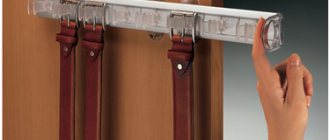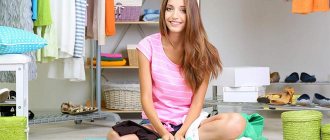If you realized that you understand LOL dolls no worse than the characters of “Game of Thrones”, you know the difference between bodysuits and vests and you spent more money on Elsa’s dress than on your own New Year’s outfit, then... Congratulations, you are a real caring parent !
If before the pain was missing a pair of Jimmy Choo shoes on sale, now you just know what it’s like to step on Legos at night.
Until recently, the apartment was a cozy place for parties, late-night movie shows and simply innocent sybaritism. And now your home is mountains of toys, scattered tights and outright rubbish that moves throughout the apartment without any logic.
The attic comes to the rescue: there is a very real way to put everything in its place and become a master of order and cleanliness in the nursery!
Lifehacks for storing children's things
Organizing the storage of children's things is a whole science. And here you will have to learn to stop finding dinosaurs in your bed, and under the dining table there is a whole city made of Lego, where you are an uninvited giant guest.
We'll tell you a couple of unusual life hacks, teach you the basic rules for sorting and storing things in a children's room, and show how logic can help you organize space wisely. Believe me, if now you feel like a freshman, by the end of the article you will become a certified specialist in storing children's things. So, let's begin!
Will never come in handy
We know and understand everything: you carefully selected every item without exception, you may have ordered something even from overseas, and this crimson bodysuit with sheep - yes, you went to the other end of town for it! But, alas, if you want to become a master of storing things in a children's room, then you need to pass the decluttering exam with a solid A - namely:
- get rid of all the clothes the child has outgrown,
- give away all the toys he no longer plays with,
- throw away everything that “we’ll fix someday”
- get rid of devices that are no longer useful.
And not an obvious point: remember that you are in a nursery and just think: if a thing doesn’t make you happy, then... Maybe it’s not needed at all? After all, what you once dreamed about, wanted, liked, may simply cease to bring pleasure. A great idea is to give it to someone to whom it will truly bring sincere joy.
Ideas for a children's room - Top 25 storage options
WICER BASKETS
Not only are wicker baskets practical, but they are also inconspicuous in the room and fit perfectly into any decor. Use them to store toys, books or clothes.
USE BUILT-IN MODULES
Built-in shelves = storage lifesaver. In a small room, they can be used as bookshelves or as a place to store tiny toys.
DON'T IGNORE THE LOWER TIER OF THE CHILD'S BED
If you still have a bunk bed after your kids go to different rooms, you can use the bottom bed as storage space. Use this space to free up space in other parts of the room.
PLAY WITH COLOR AND TEXTURES
Choose a fun print for your storage pieces and it will feel more like decor and less like a place to put away toys.
CUBES ARE YOUR BEST FRIENDS
An emphasis on separate storage drawers makes separating toys, books and stuffed animals very easy. To keep it from looking cluttered, add a few baskets instead of filling it with toys.
COMBINE STORAGE WITH A PLAY AREA
The best way to teach kids how to collect their toys: make storage part of their play area. Here, roomy standing baskets serve as a display for toy food and cooking ingredients used in the adorable play kitchen.
LARGE BAG FOR SOFT TOYS
To prevent soft toys from being scattered all over the room, store them in one large, beautiful bag where they can be seen. This way, the child will be able to see them and not worry about the fact that his pets are imprisoned in a closet or drawer.
USE UNUSUAL BASKETS
Such baskets will create a special mood in the nursery and will be an additional decor.
LOOK FOR UNBORING RACKS
A simple set of shelves is boring. Find or make fun items that add flair to your storage, like this asymmetrical shelving unit.
SPICE SHELVES ARE TO THE HELP
Who knew spice racks could be so convenient? It's very easy - and cheap - to do it yourself.
DRESSER
Choose a chest of drawers with additional shelves on top. This way you can store clothes in the drawers and toys on top.
ADD COLORS
Get creative with a basic dresser. Use color, print, texture and texture to maintain the style of the children's room.
STAIRWAY UP
Attach a ladder to the wall and use it as a bookshelf/storage alternative. It looks interesting and not banal, and each shelf can be intended for something different.
USE THE CABINET
Use the closet while your children are small and don't need it for clothes. Place a chest of drawers for books in your closet so you can store toys out of your child's sight.
USE BOXES
Mounting drawers on the wall is a way to store books and add farmhouse charm.
CONTAINERS
It is very convenient to store toys in transparent containers, since you can immediately see what exactly is there. You can also put labels on them to help make things easier to find.
SIGN THE BOXES
Help your child get dressed in the morning by labeling drawers or baskets. Since everything will have its own special place, you will never be late because you can't find the striped socks your child needs to wear.
DRAWERS UNDER THE BED
Everyone knows that under the bed is a great place to store things, but often this space turns into an unorganized mess full of garbage and dusty toys. Make special storage carts with wheels to solve this problem. Now items are organized and easily accessible.
FLOOR DRESS HANGER
Instead of putting fancy suits in the closet, put them on display. A special place for such clothes in sight will help the child get into the desired image and wear what he wants during the game. Thus making the game special.
IKEA TO HELP
Create comfortable seating and storage in your kids' playroom by flanking two Expedit bookcases from IKEA and adding fabric-covered foam cushions. Green bins placed inside each shelf help sort and store toys.
PEGBOARD
Pegboards aren't just for hardware or craft storage. Hang one in your baby's room and use it to store diapers, toiletries and other accessories.
RETHINK YOUR CLOSET
Every child loves hidden places to play. Transform an ordinary closet into a reading space and storage nook.
CREATE A GAMING TABLE
If you decide to replace your old coffee table with a new one, don't throw away the old one: turn it into a play table for your kids. This inexpensive IKEA product has been transformed into organized play space and lego storage.
MULTIFUNCTIONAL ITEMS
Multi-purpose pieces are key to any functional, hyper-organized space, so when it comes to choosing furniture like seating, look for ones that have extra storage.
SECOND LIFE FOR OLD BOXES
Don't throw away old wooden crates or boxes. You can hang them on your child's bedroom walls to store toys, books and other accessories. You can give them new life by painting and decorating them with your child.
How do you solve the storage issue in the nursery? Share your experience in the comments.
Become a classification genius
Look now in the kitchen cupboard with dishes. Forks lie with forks, spoons with spoons, and mugs with mugs. Surprised? Of course not. Organize a storage system in the children's room using the same principle. Store items of the same category together. Children love balls, soft tigers and lions and, of course, construction sets. Buy three large boxes or baskets and organize everything into categories.
A common mistake all mothers make: storing clothes together with toys. Share this universe! The planet of pink ponies is not your territory, let there be chaos over which you have no control. But organizing the storage of children's clothing is your responsibility: wash, iron, and arrange. So let there be iron order there, and no UFO will encroach on your property.
Secret #1: Reduce the number of toys
The more toys there are in the nursery, the more often children complain that they “have nothing to play with.” They simply cannot choose what to do and often dump the contents of all the boxes on the floor.
What to do? Remove from sight what the child plays rarely or does not play at all! Throw away the junk and stop buying it.
Be careful not to throw out trash right away. A piece of frayed rope and a clothespin stained with plasticine may turn out to be a snake and a dragon - your child's one and only friends! Send the garbage to quarantine, and if no one remembers about it in the coming days, then feel free to throw it away.
How to organize storage of children's things: basic rules
Rule #1. Sorting. This will seem completely radical, but the result is worth it. Look up from the article, go right now and take everything out of the cabinets and into the center of the room. Absolutely everything: what was always shifted from place to place in search of shelter, what was hidden every time on the farthest shelf before guests arrived, what was stuffed into the “rubber” drawer of the children’s bedside table every time. Open this Pandora's box already! Pulled out? Have you looked at this carnival of colors, sizes and shapes? Now divide everything into 5 groups:
- cloth,
- shoes,
- toys,
- books,
- little things.
Now we’ll deal with each group of children’s goods separately and organize a storage system for things in the children’s room.
Rule #2. Storage of children's clothes and shoes. It is better to store all clothes in one place, having previously allocated shelves for underwear. Remember that, after all, you are not in your room, but in the nursery - let your child label the shelves or drawers himself. This way he will remember better where everything is stored and will understand that all this fuss with order is not your next hysteria, but a serious operation. You’re not joking that you want to win back the taken lands for yourself, right?
Hang everything that is relevant on hangers and put it on shelves, and all the off-season stuff - in a vacuum bag (hello, Ikea!) and in the farthest corner. We bet that no one has an extra far corner, so welcome to our Attic. Who better than us will take care of winter and summer clothes. We are clean, dry and warm at any time of the year, and we will give everything away as soon as we need it.
Rule #3. Toys and books. Toys - in baskets, boxes and boxes. Pocket organizers that hang on the side of the bed or wall, baskets on rails, storage boxes hidden under the bed, in chairs, at the head of the crib, classic shelves on the entire wall (why not) - everything has already been thought up for you, look for it and find something to suit your taste. It is better to store books vertically on the lowest shelves in open access.
Rule #4. Small items. The main idea is to store small items in containers with lids. There is nothing worse than accidentally dropping a box of the smallest Legos on the floor. Close all the little things under a tight lid in a transparent box: both you and the child will immediately see what’s inside and won’t have to open it again. For the same purpose, stick on labels. Remember who has to sign everything? Yeah.
How to properly and compactly fold children's clothes into a chest of drawers?
If you ask any number of moms how they fold their baby clothes, chances are you'll get different answers. Some moms use the KonMari method and have a super organized closet for their baby. Others may quickly roll things up to get the job done.
Before we show you how to fold baby clothes, let's look at these methods and compare them.
KonMari Method
If you've been on this earth since at least January of this year, you've probably been exposed to the Konmari method. This technique was developed by Marie Kondo and focuses on organization that “ignites joy.”
This method follows six rules:
- Dedicate yourself to the idea of cleaning.
- Imagine how you want to live.
- Complete deleting items before organizing.
- Organize items neatly by category, not by location.
- Follow the correct order.
- Ask yourself if putting things away sparks joy.
When it comes to clothing, the KonMari method uses a folding method that allows the folded clothing to stand straight up. This is also known as the “filing” method and makes them more accessible and organized.
Many parents (and people in general) prefer this style of folding over the traditional technique. This is because they can see everything they have. When folding children's clothes rather than your own, the folding process is only slightly different.
I actually fold my baby's clothes this way and it makes getting ready for the morning so much faster.
Traditional folding of clothes
This is probably the folding method you're used to, with clothes stacked on top of each other in separate drawers. Some people think it's better than the Konmari method.
But when you have to pick through a bunch of other clothes just to find what you want, it turns out to be impractical. It can be inconvenient if you can't find the right shirt to wear without tearing your drawers apart.
We prefer the KonMari method because it makes clothes easier to access. Plus, by seeing everything at once, your child can't outgrow something before they can wear it.
Use delimiters
Use the main feature of children's clothing: it is small. And the shelves of the closets are made as standard for adult clothes. Use dividers and you will double the storage capacity of your closet! We show clearly what shelf dividers are.
On AliExpress, such things cost pennies, but your nerves are priceless.
Logic is the key to convenience and practicality
Adjust storage systems to suit your child's needs. What you need every day should be in sight. If your child is a young artist, put a box of pencils and albums on the table, and put plasticine and other supplies in the box: you can take them out as needed. If your child wears sports clothes more often, let them be stored on the shelf that is most convenient for his height - the one at arm level. If you often read books, place them all on the lower floors and place them vertically: you will find and get the book you need in no time.
Walls as storage space
If you don't like shelving or don't have room for classic cabinets, then there's only one word you need to know - pegboard. Fashionable, cheap, practical, unusual, in a word, all the advantages!
A pegboard is a perforated panel for wall storage of various items. The holes are intended for fastening hanging elements, shelves, baskets, hooks, etc. Next time you are in a mass market store, take a closer look, they use the same principle. You can move the shelves whenever it is convenient and do it for different tasks. By and large, you can even hang a child’s bicycle on such a wall so that the wheels don’t stain the floor.
In the hallway you can hang jackets, caps, hats, and belts on a pegboard. In the nursery, this will become a space for imagination: hang the shelves in a chaotic manner and experiment with books, games, and stationery. After all, the pegboard does not have to be on the entire wall, it can be a mini pegboard for creative supplies (hang scissors, tape, shelves for boxes with stickers and felt-tip pens - the child knows best, let him design it himself).
Shelves for children's room
Shelves come in handy when you need to fit a lot of things in a small area and when you want to create an interesting nursery design. In addition, they can be repositioned from time to time to adapt the room to the needs of a growing child.
Where to hang shelves in the nursery
- Shelves for school supplies are hung above the table or desk. They can be open or with doors (like wall cabinets in the kitchen).
- Above the bed. The main thing is to fix the shelves well and then you can literally store anything on them: from soft toys to crafts and framed photographs.
Shelves around the bed are good for storing books
- Walls on both sides of the window. Here, shelves are sometimes nailed all the way to the ceiling. Open, lightweight structures will not overload the space.
- The corner of the room is decorated with shelves that fit the shape. For symmetry, the same shelves are placed in the opposite corner.
- Accent wall. Similar to how designers highlight one wall of a room with color, use shelves to fill most of the wall. For example, near the desktop. In this case, deep shelves are not needed; those that can accommodate books or small organizers are enough.
The maximum number of shelves needed near the desktop
- Hang a simple shelf under the ceiling; a complex design will be superfluous here. For such a “high-rise” structure to look appropriate, it must occupy the entire length of the wall. Of course, you can’t put textbooks here, but this is a good place for a collection, sentimental items, and a home library.
Beautiful children's shelves: what are they?
Rectangular and square open shelves are universal: they do not get boring, do not go out of fashion, and do not lose their relevance. In addition, the simple form allows you to give free rein to your design imagination. They can not only be hung on the wall in different orders, but also placed one on top of the other on the floor, creating shelving. Combine with similar shelves with a door.
Unusual shelves:
- Asymmetrical and curved ones will decorate the wall in a child’s or teenager’s room.
Curved shelves above the table for small items and books
- Shelf-add-on desk. Buy it at the same time as the table or later choose a model that matches the design. The shelf is fixed on the wall, but looks like a continuation of the table - you get a work area in the same style.
- Preschoolers love story shelves in the shape of a house, airplane, cloud, flower, balloon, rocket, ship, steering wheel, animals, and so on. You need 1-2 such shelves to make an accent in the interior, but not to make it flashy.
You can make a wooden airplane shelf with your own hands
- Shelves made from wooden boxes are sold in furniture stores, but you can make them yourself. Buy identical wooden boxes at the garden center, paint them or varnish them. Hang these shelves on the wall or assemble them into a floor rack. They are durable and look stylish.
- Various geometric shapes: oval, triangle, hexagon, circle.
Round shelves look very unusual in the interior
- A ladder is a solid step-shaped shelf or individual parts nailed in this way. The ladder creates dynamics in the interior and looks good above the table and above the bed.
- Use objects as shelves. For example, an old guitar or skateboard. This is appropriate if it reflects the child’s character and hobbies. Such design options are not suitable for storing a significant amount of things, but they will become the highlight of the interior.
Shelves made of stylish things are an interesting idea for a teenager’s room
- Shelves under the window (open and closed) are convenient for storing toys and small items in containers and boxes.
- Wooden shelf for books, toys, souvenirs. Support the concept with other room decor elements or color. For example, hang green wallpaper or place several photo frames in the shape of apples or leaves.
A shelf in the shape of tree branches is suitable for a child’s room of any age.
Beds as storage space
www.ikea.com
A functional bed is a trend not only for children. New York style, replacing the Scandinavian coziness, will become close to everyone who is limited in space. This is where beds with built-in storage drawers come in handy. We are used to the fact that we can put our laundry there, but now we can order a functional bed with drawers of different sizes and store clothes, shoes, personal items, art supplies and, of course, toys there.
www.pinterest.com
Dresser Organization
Well, I decided to show our chest of drawers for now. I am absolutely sure that a lot will change with the arrival of the baby, with her growth, with my needs, with more or less used products and things. But that's it for now.
The post, as always, is more for myself as a keepsake. But if there are any special comments, I’ll be glad to listen.
I moved the changing mat from left to right and back several times. I haven’t decided which is more convenient. It seems that it is more convenient for all sorts of jars to be on the right and to be taken with the right hand, but on the other hand it is better for the baby to be against the wall. For now I left the mattress on the right.
On top of the dresser
- a container with cotton swabs with a limiter
- a container with regular cotton swabs
- container with cotton pads of different sizes
— a long container (I don’t know what it’s for yet), so for now there are all sorts of miniature oils, as well as antibacterial hand gel (I’ll apply it before hygiene procedures). I don’t plan to use oils, etc., but for now there’s nowhere else to put them
— 3 in 1 thermometer (ear, forehead, and room temperature)
— hydrometer + thermometer 2 in 1 (I’m checking how it works for now, then it will move to the wall)
- container with wet wipes
- a container with regular paper napkins
- A 3-story thing from Ikea - I also don’t know what to put in there yet, but I think over time there will be all sorts of small things
1 Box
| Far left separator: | Middle distance separator: | Far right separator: |
| Nipples and anything related to them (donated) - clothespins for nipples, a mini sterilizer, wet wipes for nipples, nipple boxes, etc. | wet wipes | disposable diapers (they are on the bottom) and a diaper on top for the mattress |
| stock of bags for dirty diapers | cotton pads of different sizes | |
| Left front divider: | Middle front divider: | Right front divider: |
| Type 1 diapers | Type 2 diapers | First aid kit |
| box with bags for dirty diapers | box with bags for dirty diapers |
2 Box
— In the separator with 30 cells, bodysuits (with short and long sleeves), rolled up with rollers. 1 row of cells - 1 size. I got: newborn, 0-3 months, 3-6 months. My slips hang on hangers in my closet so they don’t get wrinkled, so don’t be surprised that they aren’t here. Maybe over time they will move to a box - we'll see.
- thin hats
- socks
- cloths for everything (IKEA Forever) + several large muslin napkins.
By the way, I found super cool colored rags in Ikea - in quality and size - exactly the same as the famous white ones with colored pendants here, and they even cost a couple of kopecks cheaper, but the colored ones are so pleasing to the eye!!! They come in a set of 4 and I found them in the bathroom department. Don’t ask for a link - I live in London - at most I can give a link to the English Ikea, and it’s not a fact that the collections are the same.
3 Box
Hahahahaha - half empty - I seriously don’t know what to store there... First of all, I need to buy more dividers. In the meantime, I have here bibs, warm hats and mittens, tights and teethers.
4 drawer - mom's
For now, all sorts of nonsense lives here - pads, an ergo backpack that my husband bought for himself, all sorts of little things. Again, over time I will definitely change and reorganize it for better convenience, but for now I don’t know where to put it and how it will be more convenient. I’ll get my bearings in practice.
Thanks to those who watched it.
Lifehacks “here and now”
If you don’t yet have the opportunity to purchase a functional bed or replace shelving, we offer a couple of useful ideas that can be applied right now.
Curtains. Create the illusion of minimalism by curtaining open, congested areas with fabric in your favorite color.
www.pinterest.com
Laundry basket. A dirty child is a normal child. That’s why you don’t have a “week” set, but rather a “monthly” set, that is, about 20 T-shirts for 5-7 days! From your child’s clothes, you can easily guess where he was and what he was doing: eating pizza, drawing with felt-tip pens, playing with kinetic sand.
T-shirts are changed, and dirty laundry needs to be stored somewhere. Place a basket for it right in the room next to the closet. Teach your child the rule: take off dirty items and put them in the basket. If he learns it, you will forget what dirty clothes are scattered throughout the apartment.
www.houzz.in
Hooks to work! Hooks can be hung on the wall to store jackets, tracksuits, bags and backpacks. They can also be attached inside the cabinet directly to the door. Well, the real hit of the season are chairs with hooks for clothes. Coming home from school, hanging your jacket on a chair, doing your homework, immediately throwing it back on and running off for a walk - convenient! And the chair can also be a ladder at the same time - then the child will have free access to the upper shelves. You can store desktops there, for example, which he can get out himself without interrupting you from worries around the house or work.
How to put children's things in a chest of drawers using the Konmari method?
For each type of clothing, there is a special way to fold it for storage using the filing method. Each piece of clothing has its own unique fold.
There are a few general rules when folding clothes using the KonMari method:
- Make sure you have a clean, flat surface to hand: this will make folding much easier as you will have room to fold and can do it correctly.
- Smooth out your clothes as you fold them: this will prevent you from having a bulky final product. This can also help with creases.
- The final product should be able to stand on its own: you'll find that clothes folded using the KonMari method fold into three sections for this very reason. Since it is stored vertically, you need to make sure it sits straight in the drawer.
- Leave 2.5 or 5cm of space at the top: this will also help ensure the product stands on its own.
- Organization is key: The point of folding is to have a more organized drawer. Marie Kondo recommends purchasing drawer dividers or small boxes to store items like socks and underwear. This will keep them from getting mixed up together or, worse, getting lost.
Folding baby bodysuits and T-shirts
To fold your bodysuit, start by laying it flat. The next thing you want to do is fold the bodysuit inward, lengthwise, on each side, and tuck in the sleeves. Take your hands and smooth down the bodysuit again to smooth out any lumps or wrinkles.
You will then fold the bodysuit in three stages, starting from the bottom. Make sure the folds are straight and clean. This will allow you to place the bodysuit straight in the drawer and it will take up minimal space.
Folding children's shirts
When you fold a shirt, you should start folding one side of the shirt. Take your shirt sleeve and fold it back onto the folded panel you just made. Then you will repeat on the other side.
Be sure to iron the shirt to remove any wrinkles and then fold it in half, but leave a small gap at the end. Finally, you will fold the shirt into thirds and then it will be ready to be put away.
Hooded sweatshirts can be folded in the same way. The only extra step is to fold the hood after you fold the sleeves.
Folding children's trousers
To fold pants using the KonMari method, simply lay the pants on a flat surface and then fold one pant leg on top of the other. Make sure the crotch is tucked in and fold the pants almost in half, leaving some room at the top.
Once you've done this, fold your pants into thirds from the bottom up to give them the size they need to stand up straight.
Folding children's pajamas
Pajamas seem daunting to fold, but they really aren't. To fold them, you simply lay them flat and start folding the sleeves. You will then lift the two pant legs up until they are almost folded in half.
Once you have done this, fold it in half and then it will be ready to be placed in the box.
Folding baby socks
While many people fold socks by stacking one on top of the other, there is a much more efficient way to do it. Stacking your socks on top of each other can sprain your ankle and ruin the fit. To fold socks the Konmari way, simply place one sock on top of the other.
Once you do this, simply fold them in half. Then place them in a divider box that can fit right into your child's sock drawer.
Folding underwear
If you're currently potty training you might be wondering how to fold those tiny pairs of underwear. Folding underwear is easy with KonMari.
Start by laying your underwear on a flat surface. Then you'll fold the bottom up so it forms a long, skinny rectangle. Once you've done this, fold them in half twice so they make a small square. That's all there is to it.
The results of your efforts
All our advice is aimed at ensuring that you do not rebuild your apartment into one large children's room, but make the child's room an organized, smart space in which it is cool to play, you can easily find your favorite thing and conveniently use the dressing room.
But we know that there are always more children's items than an ordinary apartment can accommodate. Therefore, we suggest handing over all seasonal clothes, favorite toys that are dear to you, and a stroller for your future sister or brother to the cloud storage warehouse. In our Attic, things are stored in ideal conditions: always +20 degrees, cleaning and ventilation strictly once a week, and 24-hour security with video surveillance.
Our movers come to your home themselves, carefully pack and take children's things for storage. Parents are our regular customers, as every season we store scooters, bicycles, skateboards, strollers, cars, and seasonal clothing.
www.amazon.com
This huge plush Dalmatian here could be collecting dust and taking up a ton of space in a nursery, but instead it is stored in our warehouse and the client will receive it back safe and sound. Why part with something dear forever when you can give it to us?
Taking care of you and your things, Attic.
How to fold things quickly: advice from experienced housewives
After reading the instructions above, many may object, because it can take precious hours to fold things beautifully. Experienced housewives will object and offer a number of tips.
Do you want neat bedding, but don't want to iron it? All you need is fabric softener and a little skill. While hanging, distribute the sheets and duvet covers so that the same length of rope hangs on both sides, so the crease will be in the middle (when ironing, it turns out exactly the same).
Straighten the fabric so that it is evenly stretched and under its own weight the bedding will dry and stretch; all that remains is to iron the pillowcases, since due to its small size the fabric does not stretch out so perfectly. Now, having removed it from the rope, immediately fold it into an even pile and, after ironing the pillowcase, place the folded pieces inside. This reduces bed linen care time by an average of 50%.
Bed linen in a pillowcase - order on the shelf
With towels the task becomes a little more complicated. When replacing towels, purchase 100% bamboo. These towels are softer and absorb moisture better. Another advantage of them is that they do not need to be ironed and, therefore, they can be put into piles immediately after being removed from the rope.
Another piece of advice from experienced housewives is to master the technique of how to fold things, even if it takes more than one week. You'll then be folding in seconds right after ironing, and this part of the job will only take you 15-20 minutes to neatly fold for the whole family!
And some advice from a famous blogger - a hostess and a beauty. Let's learn from the wonderful Natalia.











